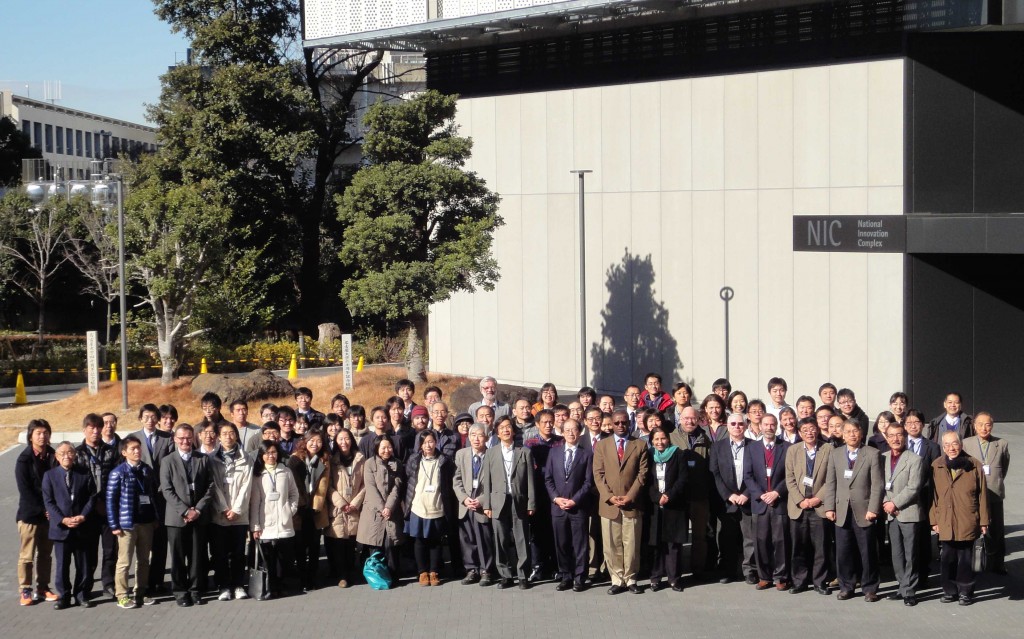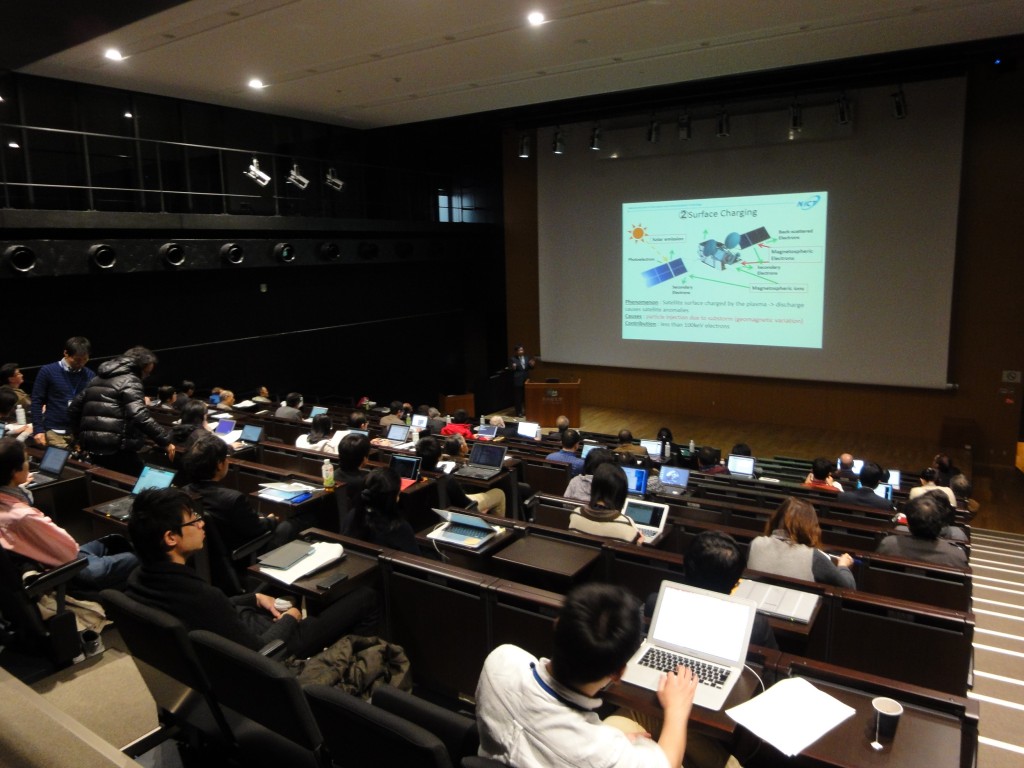本領域では第1回国際シンポジウムPSTEP-1 “Toward the Solar-Terrestrial Environment Prediction as Science and Social Infrastructure”を、名古屋大学ESホールにおいて、2016年1月13~14日に名古屋大学宇宙地球環境研究所との共催で実施しました。この国際シンポジウムには100余名の研究者が国内外から集まり、講演・討論会・ポスター発表を通し、太陽地球圏環境予測に関する最新の研究と国際連携の在り方などについて活発な議論を展開しました。本領域ではこの国際シンポジウムの成果をもとに、積極的な国際展開を目指していく予定です。
International Symposium PSTEP-1
Toward the Solar-Terrestrial Environment Prediction as
Science and Social Infrastructure
Date: January 13 (Wed) – 14 (Thu), 2016
Venue: ES Hall in Higashiyama campus of Nagoya University.
MAP: http://en.nagoya-u.ac.jp/map/
ACCESS: http://en.nagoya-u.ac.jp/access/
URL: https://www.isee.nagoya-u.ac.jp/pstep/information_en/events_en/151021_en.html
Organizer / Host: Project for Solar-Terrestrial Environment Prediction (PSTEP)
Co-host: Institute for Space-Earth Environmental Research (ISEE), Nagoya University
PSTEP is a nation-wide project, which was recently established with the support of the Grant-in-Aid for Scientific Research on Innovative Areas from MEXT/Japan. In this project, we are aiming for synergistic development of the solar-terrestrial science research and the next generation space weather forecast. The 1st PSTEP International Symposium is a forum to discuss the current status and future prospect of solar-terrestrial environment prediction, and also provides a valuable opportunity to formulate the international joint research planning for space weather and space climate study. We welcome everyone who is interested in solar-terrestrial environment prediction.
Science organizing committee:
Kanya Kusano, Mamoru Ishii, Kiyoshi Ichimoto, Yoshizumi Miyoshi, Shigeo Yoden, Kazuo Shiokawa, Shinsuke Imada
Contact: inquiry@pstep.jp (PSTEP Secretariat, Nagoya University)
Program: (Time allocation is given as presentation + discussion in min)
12 Jan (Tue)
17:00-18:00 Registration (ES Hall, Nagoya University)
18:00-19:00 Icebreaker (Restaurant chez Jiroud, Nagoya University)
13 Jan (Wed)
9:00-9:30 Registration
9:30-11:05
Session 0. Project overview
Kanya Kusano (PI of PSTEP, Nagoya University, Japan) (15+10)
The PSTEP project
Session 1. Next Generation Space Weather Forecast
Mamoru Ishii (group leader of PSTEP-A01, NICT, Japan) (20+15)
Goal and strategy of the PSTEP-A01: Next generation space weather forecast
Terry Onsager (NOAA, USA) (20+15)
Establishing priorities for improving space weather forecasts
11:05-12:05 Group photo & Poster session
12:05-13:00 Lunch
13:00-15:45
Zahra Bouya (BoM, Australia) (20+15)
Data driven models in support of SWS activities for
regional ionospheric specification and forecasting
Tsutomu Nagatsuma (NICT, Japan) (10+10)
Toward mitigating impact of spacecraft charging problem
Hiroshi Yasuda (Hiroshima University, Japan) (10+10)
Radiation protection of humans in space and aviation: Current states and future needs on the warning system for aviation exposure to SEP (WASAVIES)
Session 2. Prediction of solar storms
Kiyoshi Ichimoto (group leader of PSTEP-A02, Kyoto Univ., Japan) (20+15)
Goal and strategy of the PSTEP-A02: Toward the advanced prediction of solar storm
K. D. Leka (NorthWest Research Associates, USA) (20+15)
The present state of forecasting solar flares
Takayuki Muranushi (RIKEN, Japan) (10+10)
An automated solar flare forecast service using UFCORIN
15:45-16:10 Coffee break
16:10-18:00
Yong-Jae Moon (Kyung Hee University, Korea) (20+15)
Lessons from empirical and neural network space weather forecast models
Dusan Odstrcil (George Mason University, USA) (20+15)
Near real-time simulation of heliospheric space weather
Bernie Jackson (UCSD, USA) (10+10)
Using world interplanetary scintillation systems for space weather predictions
Daikou Shiota (Nagoya Univ., Japan) (10+10)
MHD simulation of interplanetary propagation of multiple coronal mass ejections with internal magnetic flux rope (SUSANOO-CME)
18:30-20:30 Conference dinner (Restaurant HANA-NO-KI, Nagoya University)
14 Jan (Thu)
9:30-11:55
Session 3. Prediction of magnetosphere and ionosphere dynamics
Yoshizumi Miyoshi (group leader of PSTEP-A03, Nagoya Univ. Japan) (20+15)
Goal and strategy of the PSTEP-A03: Prediction of magnetosphere and ionosphere dynamics
Tamas I. Gombosi (University of Michigan, USA) (20+15)
Space weather modeling at Michigan: From concept to operations
Endawoke Yizengaw (Boston College, USA) (20+15)
The geomagnetically induced currents at the equator associated with the interplanetary shocks
Kazuo Shiokawa (Nagoya University, Japan) (10+10)
Ionosphere subgroup of PSTEP A03 (Geospace Dynamics)
Shinichi Watari (NICT, Japan) (10+10)
Measurement of geomagnetically induced current in Japan
11:55-13:00 Lunch
13:00-14:45
Session 4. Prediction and understanding of solar cycle activity and its impact on climate
Shigeo Yoden (group leader of PSTEP-A04, Kyoto Univ., Japan) (20+15)
Goal and strategy of the PSTEP-A04: Prediction and understanding of solar cycle activity and its impact on climate
Margit Haberreiter (PMOD/ World Radiation Center, Switzerland) (20+15)
Eleven-year and long-term variations in solar UV radiation and its effect on the Earth’s atmosphere and climate
Limin Zhou (East China Normal University, China) (20+15)
The possible link between space weather and earth weather and climate by global electric circuit
14:45-15:30 Poster viewing
15:30-17:30
Dan Marsh (NCAR, USA) (20+15)
Whole atmosphere modeling of solar-terrestrial coupling
Hidekatsu Jin (NICT, Japan) (10+10)
Vertical atmospheric coupling studied with a whole atmosphere-ionosphere coupled model GAIA
Hiroko Miyahara (Musashino Art University, Japan) (10+10)
Investigating the cosmic-ray impact on climate in the past
Session 5. General Discussion and concluding remark (45)
17:30 end of the symposium
Posters
|
No. |
Name |
Title |
|
1 |
Tsutomu Nagatsuma |
Nowcasting of space environment around GEO based on Energetic Particle Observations by GOES, Himawari-8, and Kodama |
|
2 |
Daikou Shiota |
Development plan of an interconnection framework for space weather models in PSTEP |
|
3 |
Shunya Kono |
Reflection and Mode Conversion of Alfven Wave in the Solar Chromosphere |
|
4 |
Shinsuke Takasao |
Systematic Numerical Study of Origin of Flare-productive Active Regions |
|
5 |
Takako T. Ishii |
Observations with Solar Magnetic Activity Research Telescope (SMART) at Hida Obs., Kyoto-U. |
|
6 |
Naoto Nishizuka |
Solar Flare Prediction with Machine-learning of Real-time Vector Magnetogram Data |
|
7 |
Kumi Hirose |
Filament Disappearances Observed with SMART, Hida Observatory |
|
8 |
Yuki Kubo |
Newly developed solar radio telescope for space weather forecast and research |
|
9 |
Hiroaki Misawa |
Development of a new solar radio telescope in the HF to VHF band |
|
10 |
Kazutaka Kaneda |
Relationship between Solar Eruptive Phenomena and the Spectral Fine Structure in Solar Radio Bursts |
|
11 |
Sachiko Akiyama |
A Comparative Study of Eruptive and Confined Solar Flares using Microwave |
|
12 |
Seiji Yashiro |
Propagation of Coronal Mass Ejections and the Solar Wind Speeds Estimated from the IPS Observations |
|
13 |
Katsuhide Marubashi |
Problems in geomagnetic storm prediction based on interplanetary magnetic flux ropes |
|
14 |
Tomoya Iju |
Three dimensional MHD Simulation of CME-CIR Interaction |
|
15 |
Nishiki Nozaki |
Statistical studies for prediction of IMF-Bz (1) |
|
16 |
Nobuhiko Nishimura |
Statistical studies for prediction of IMF-Bz (2) |
|
17 |
Naoko Takahashi |
Global evolution and propagation of electric fields during sudden impulses based on multi-point observations |
|
18 |
Satoshi Kurita |
Relativistic electron microbursts and flux variations of trapped MeV electrons: SAMPEX and Van Allen Probes observations |
|
19 |
Masahiro Kitahara |
Wave-Particle Interaction Analyzer for interaction between whistler-mode chorus emissions and energetic electrons |
|
20 |
Yuto Katoh |
Dependencies of the generation process of whistler-mode chorus on the kinetic energy of anisotropic electrons in the Earth's inner magnetosphere |
|
21 |
Shoya Matsuda |
Plasma Diagnostics in Plasmasphere by Using Ion Cyclotron Whistlers |
|
22 |
Akiko Fujimoto |
Space weather environment index based on ICSWSE magnetometer network |
|
23 |
Masaki Kuwabara |
The geocoronal responses to the geomagnetic storms |
|
24 |
Takahiro Obara |
Mechanisms of theta aurora formation |
|
25 |
Takashi Kikuchi |
GIC as a return of the global ionospheric currents |
|
26 |
Prayitno Abadi |
East-west Asymmetry of Scintillation Occurrence observed by GPS Receivers in Asia |
|
27 |
Tam Dao |
F-region Field-aligned Irregularities observed with Equatorial Atmosphere Radar and GPS data |
|
28 |
Kornyanat Watthanasangmechai |
Small amplitude plasma bubble clusters observed in Southeast Asia |
|
29 |
Hiroyuki Shinagawa |
Estimation of Occurrence Probabilities of Plasma Bubbles and Sporadic E layers Using GAIA |
|
30 |
Nozomu Nishitani |
SuperDARN observation of ionospheric density changes associated with solar flares and energetic particle precipitation |
|
31 |
Yusuke Ebihara |
Study on GIC on the Japanese Islands |
|
32 |
Shigeru Fujita |
Estimation of the geomagnetically induced current in Japan – modeling of the induced electric field and empirical estimation of the induced current at a transformer station – |
|
33 |
Tada-nori Goto |
Review of crustal structure in and around the Japan island obtained by magnetotelluric soundings |
|
34 |
Hiroki Matsushita |
Development of dense magnetometer array in Peru for investigating detailed structure of EEJ |
|
35 |
Wataru Sakashita |
Tree-ring cellulose oxygen isotopes evidence for a humid climate in central Japan during the last stage of the Little Ice Age |
|
36 |
Yasushi Muraki |
The 11-year variation recorded in Yaku cedar tree ring–What does this mean? |
|
37 |
Harufumi Tamazawa |
Database of naked-eye sunspot and low-latitude aurora in pre-telescopic era recorded in the ancient documents |
|
38 |
Ayumi Asai |
Solar ultraviolet radiation estimated from solar images |
(Rev. 2016.01.14a)



